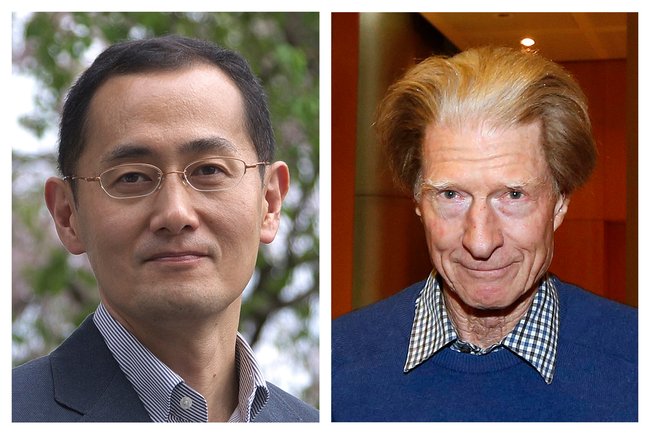A pair of landmark discoveries in cell biology made more than 40 years apart have earned the 2012 Nobel Prize in Physiology or Medicine for John B. Gurdon of the University of Cambridge in England and Shinya Yamanaka of Kyoto University in Japan. The prize was announced in Stockholm on Monday. The discoveries concern the manipulation of living cells, and lie at the heart of the techniques for cloning animals and generating stem cells, the primitive cells from which the mature tissues of the body develop. Dr. Gurdon was the first to clone an animal, a frog, and Dr. Yamanaka discovered the proteins with which an adult cell can be converted to an egg-like state.

Both men made false starts in life. Dr. Gurdon was told as a boy that he was wholy unsuited for biology, and Dr. Yamanaka trained as a surgeon only to find he was no good at it.
The techniques they developed reach to the beginnings of life, and have generated objections from people who fear, on ethical or religious grounds, that scientists are pressing too far into nature’s mysteries and the ability to create life artificially.
Biologists have pushed ahead nonetheless, believing that manipulations like these may lead to regenerative medicine, the hope of repairing or replacing stricken organs with the body’s own cells.
Dr. Gurdon’s discovery came in 1962, when he produced living tadpoles from the adult cells of a frog. His work was at first greeted with skepticism, because it contradicted the textbook dogma that adult cells are irrevocably assigned to their specific functions and cannot assume new ones. (His prize was the first Nobel to be awarded to a cloner.)
Dr. Gurdon’s technique was to extract the cell nucleus, containing the frog’s DNA, from a mature intestinal cell and inject the nucleus into a frog egg whose own nucleus had been removed. The egg was evidently able to reprogram the introduced nucleus and direct its genes to switch from the duties of an intestinal cell to those appropriate to a developing egg.
But how did the egg cell body accomplish this reprogramming feat? The answer had to wait for 44 years, while molecular biologists gained a more intimate understanding of genes and the agents that control them.
Working with mice, Dr. Yamanaka discovered in 2006 that the reprogramming is accomplished by just four specific gene control agents in the egg. The agents, known to biologists as transcription factors, are proteins made by master genes to regulate other genes. By injecting the four agents into an adult cell, Dr. Yamanaka showed that he could walk the cell back to its primitive, or stem cell, form.
Stem cells generated by this method, known as induced pluripotent cells, or iPS cells, could then be made to mature into any type of adult cell in the body, a finding with obvious potential for medical benefits.
Many biologists hope that Dr. Yamanaka’s technique will be the gateway toward generating replacement tissues from a patient’s own cells for use against a wide variety of degenerative diseases. For the moment, that remains a distant prospect. But the cells have already proved useful in studying the genesis of disease. Cells generated from a patient are driven to form the tissue that is diseased, enabling biologists in some cases to track the steps by which the disease is developed.
Dr. Gurdon’s early academic career did not hint at what the future might hold. “I believe Gurdon has ideas about becoming a scientist; on his present showing this is quite ridiculous,” his high school biology teacher wrote. “If he can’t learn simple biological facts he would have no chance of doing the work of a specialist, and it would be a sheer waste of time, both on his part and of those who would have to teach him.”
After this verdict, the 15-year old John Gurdon had to spend the rest of his school time studying Latin and Greek. But spurred by a fascination with the color patterns on the wings of butterflies and moths, he did not forget his interest in the mystery of how animals develop, and in 1956 he got himself accepted for graduate work in the embryology department at Oxford University.
There a more encouraging mentor, the Latvian scholar Michail Fischberg, encouraged him to try transplanting the nucleus of adult cells into frog eggs. The idea was to see if the genome — the hereditary information — stayed unchanged during development or underwent irreversible changes. Earlier experiments in the United States had suggested the genome did change as an animal developed, implying it would never be possible to clone an animal from a single cell, as can be done with plants.
Using a different species of frog from those in the American experiments, Dr. Gurdon found he could produce living tadpoles from the nucleus of adult frog cells, showing that the genome of both egg and adult cells remained essentially unchanged.
His experiment showed in principle that animals, including humans, could be cloned. But this possibility did not seriously impinge on the public imagination until his experiment was reproduced in mammals with the generation of Dolly, the cloned sheep, in 1997. The following year saw generation of the first human embryonic stem cells, which are derived from the early human embryo. Such cells are called pluripotent because they have the potential to develop into any of the mature tissues of the body.
The two developments led to the concept of therapeutic cloning — take a patient’s skin cell, say, insert it into an unfertilized human egg so as to reprogram it back to pluripotent state, and then develop embryonic stem cells for conversion into the tissue or organ that the patient needed to have replaced. Since the new tissue carried the patient’s own genome, there should be no problem of immune rejection.
There were ethical objections to such a scheme, since it would constitute the first step toward cloning a person. But the practical obstacles were almost as severe: human eggs are not so easily obtained. Of course, the reprogramming might be accomplished without human eggs if only the relevant factor in the egg could be isolated. But that seemed a distant prospect until Dr. Yamanaka’s discovery.
Trained in orthopedic surgery and molecular biology, Dr. Yamanaka was interested in the factors that maintain an embryonic stem cell in its embryonic state. The cell’s goal is to burst into the hundreds of different cell types that emerge during development, but it is held back until the right time. In 2003 Dr. Yamanaka, in parallel with another group, identified one of these restraining factors, a transcription factor made by a gene called Nanog.
He then developed the idea that among all the transcription factors present in embryonic stem cells, there should be some that were responsible for reprogramming a transplanted cell nucleus back to embryonic state. He identified 24 likely candidates, hitched their genes to a virus, and infected mouse skin cells. The fruit of this inspired guesswork was that a few of the cells produced colonies of what looked very like embryonic stem cells.
With further experiments, he whittled down the essential factors to just four. In the strange argot of molecular biology, they are the products of the four genes known as Myc, Oct4, Sox2 and Klf4.
His finding, reported in 2006, was immediately recognized as a game-changing method that opened up a new field of research. Other scientists improved the method by dispensing with the use of viruses and have shown how different sets of transcription factors can convert one type of cell to that of a quite different lineage.
Dr. Gurdon and Dr. Yamanaka will receive a handsome cash prize, but one reduced by 20 percent from previous years. The Nobel Foundation announced in June this year that its investments had not kept pace with expenses over the past decade, and that to ensure the prize would be awarded “in perpetuity,” the prize money would be reduced from 10 million to 8 million Swedish krona. Still, at today’s exchange rate even this is worth $1.2 million.
In a brief interview today, Dr. Yamanaka, who was born in 1962 in Higashiosaka, Japan, said that he had trained as surgeon but “gave it up because I learned I was not talented.” Having seen how little the best surgeons could do to help some patients, he decided to go into basic research and did postdoctoral training at the Gladstone Institute in California.
“When I came back to Japan in the 90’s I suffered from a disease which I called PAD — post-America depression,” he said.Another Japanese Nobel prizewinner, Susumu Tonegawa of the Massachusetts Institute of Technology, has criticized the lack of research freedom given to scientists in Japan. Dr. Yamanaka said that there were still some problems, but that conditions had become much better since Dr. Tonegawa moved from Japan. Dr. Tonegawa won an unshared Nobel prize in 1987 for discovering the basis of antibody diversity.





